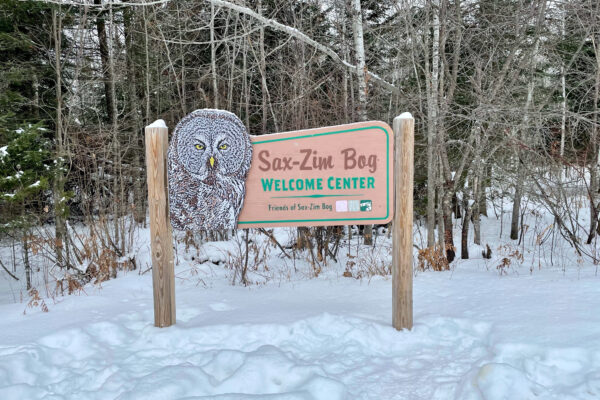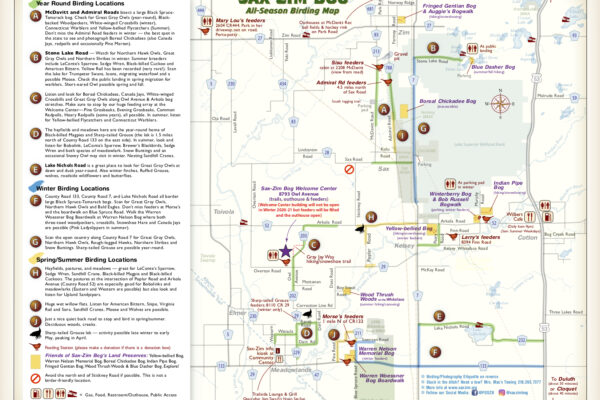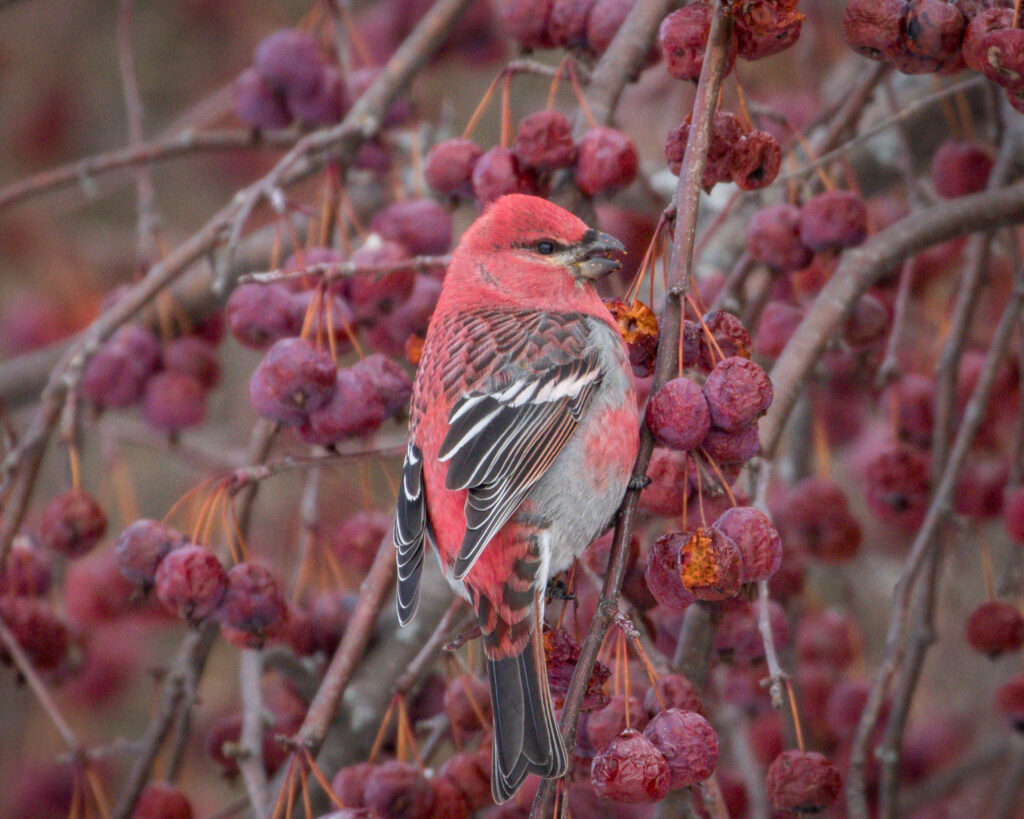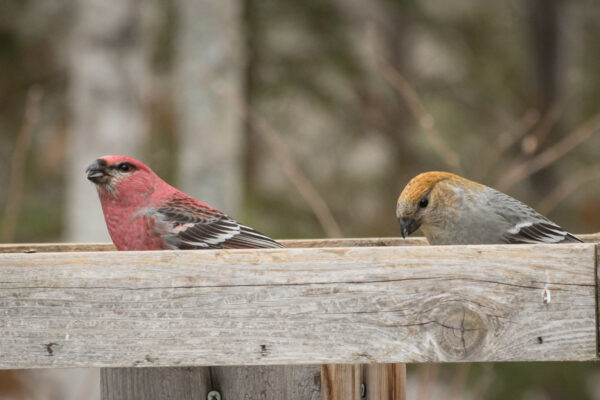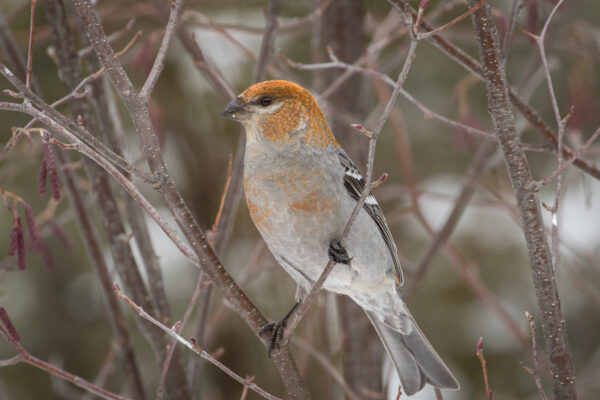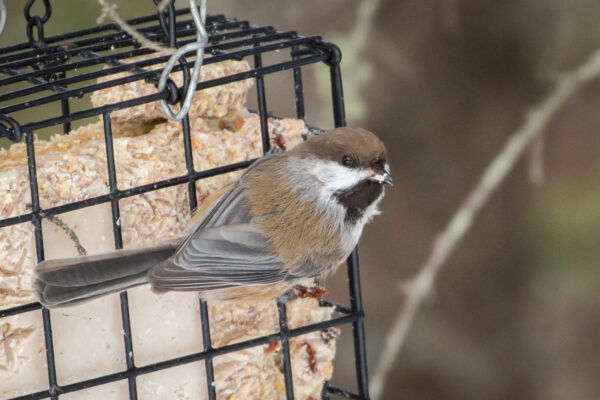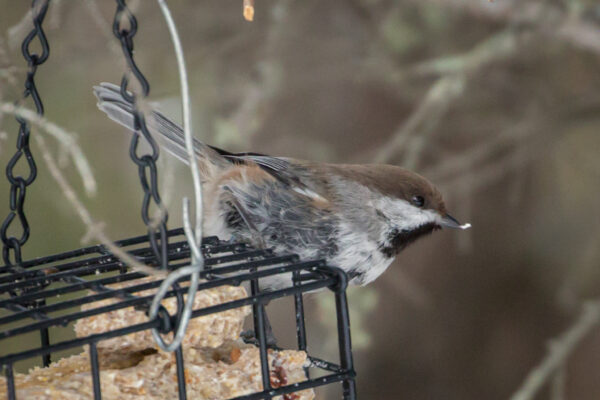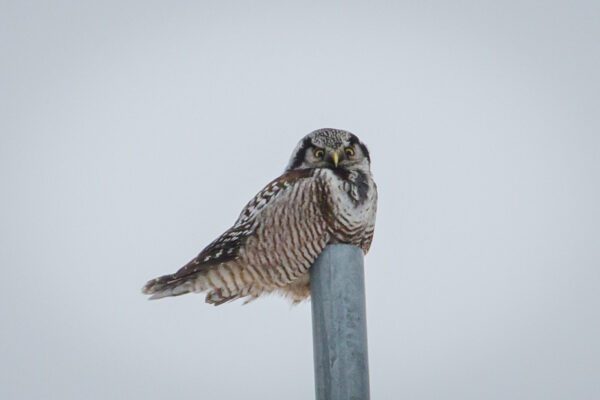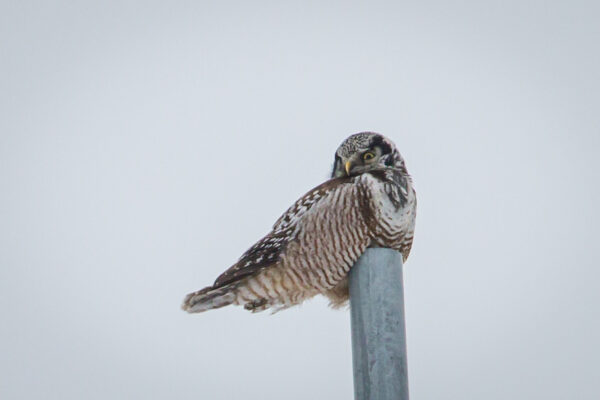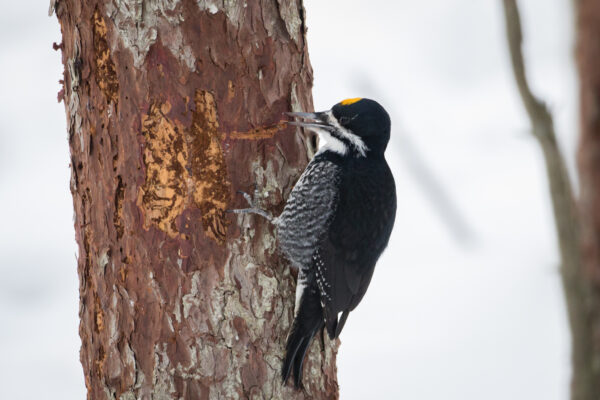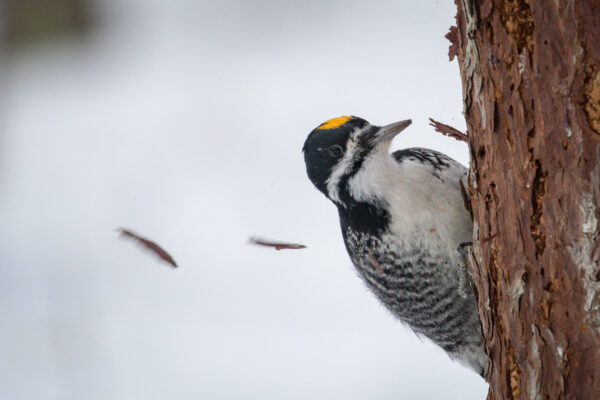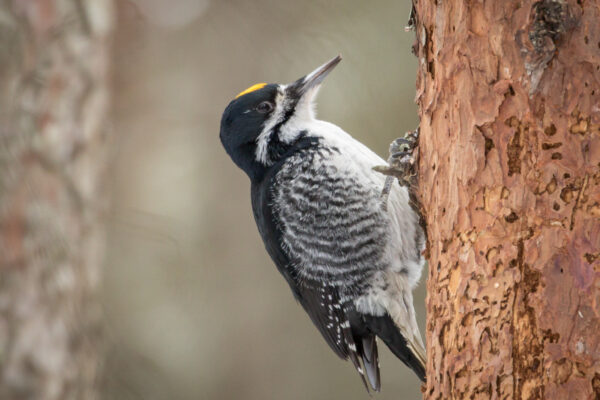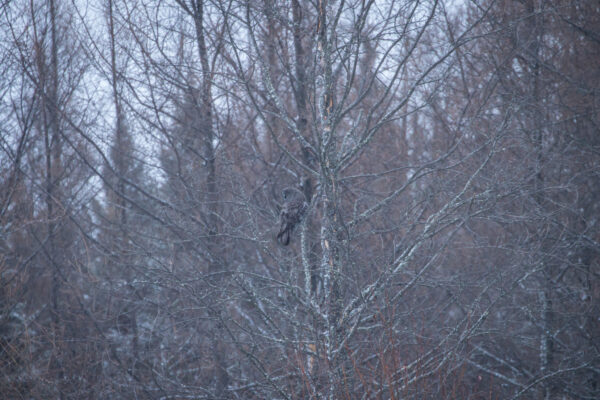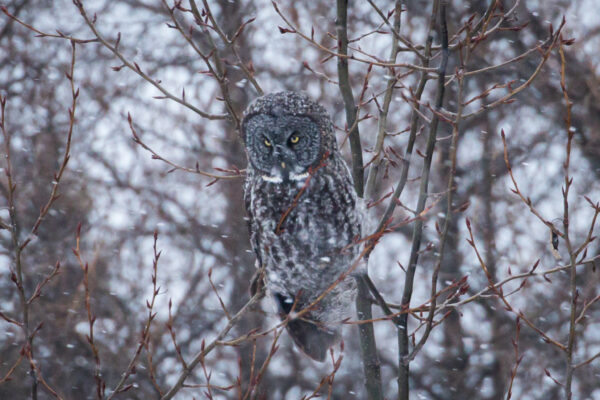Our First Visit to Sax-Zim Bog
As I was dropping my car off at the shop last week I mentioned to Kerry I was going to be out of town a few days, so they could take their time. “Where you going?” Kerry asked. “We’re heading to a spot called Sax-Zim Bog, a little north of Duluth” I replied. “Brrrr. Why up there?” “Going Birding” I said. At which point Kerry unconsciously took a half-step back like I had COVID and grumbled “Haveagoodtime.”
To tell you the truth we had never even heard of Sax-Zim Bog until recently. Birder Buddies would come up to us and tell us of their plans to go north in the cold of winter – we usually had plans to go south. We would constantly get comments like “You haven’t been up there? You gotta go to The Bog!” Others were incredulous we hadn’t been there already.
Sax-Zim Bog is one of those places would have only heard about if you were a birder; it’s quite famous in the birding community, with people coming from all over the world see and photograph the boreal birds.
I found several aspects of the region quite fascinating so we start this off with some background information about Sax-Zim Bog. Next I describe our birding experiences at The Bog. Finally we’ll get to some bird pictures, specifically the 5 Lifers we saw. Here’s a map of the area to get you acclimated – click on it to go to the Friends of Sax-Zim Bog’s website where you can download the map yourself.
Background Of The Sax-Zim Bog Region
Sax-Zim Bog is an area of roughly 300 square miles within St. Louis County, Minnesota (this is the largest county east of the Mississippi) and is about 40 miles north-west of Duluth. In general the area is the southern-most extension of the Canadian Boreal Forest. The name Sax-Zim comes from two towns that disappeared early in the 20th century. The town of Sax was named after the founder and owner of the town, Solomon Saxe. The town of Zim’s name came from Zimmerman, a lumberman who worked a logging camp in the area. The only remnants of these towns are the roads named after them which cut through the bog and an abandoned post office.
A bog is a wetlands area with a lot of vegetation. As leaves and pine needles fall off the trees they accumulate on the ground, creating a wet spongy surface that is difficult to walk through (hence the term “bogged down”). Over time the thick layers of decaying plant life turns to peat. Upland areas include Norway Pine, White Spruce, Aspen, Birch, Jack Pine and Balsam trees. Lowland areas include Black Spruce, Tamarack, and Northern White Cedar.
Today the Sax-Zim Bog region is a patchwork of habitats including forests, active agricultural fields, abandoned farmlands, and a growing number of conservation areas. All of which attract a wide variety of birds and mammals such as squirrels, voles, mice, ermine, lynx, and even moose.
The abandoned farmlands add an interesting side-story to the current revitalization of the region. When farmers first went there back in the 1800’s they built a series of ditches in an attempt to drain the bog so they could plant crops. Unfortunately for them it’s very difficult to drain a bog – many of the farms failed. When the farmers abandoned the fields their farm became the property of the Tax Forfeit Lands of St. Louis County.
Fortunately for us this land is slowly being reclaimed and restored. A great example of this took place in 2014. The Nature Conservancy worked a first-of-its kind property exchange. Potlatch, a large corporate forestland company, owned property within the region; the trees on the property had been farmed and the land lay vacant. St. Louis County, along with the Minnesota School Trust, found lands of interest to Potlatch outside of the region. They exchanged the properties – the land acquired in Sax-Zim Bog was then purchased by Ecosystem Investment Partners, who are now restoring 22,000 acres back to its natural bog habitat. There are other groups actively working to maintain the bog, most notably the Friends of Sax-Zim Bog, who are doing so specifically to promote birding in the county.
How Sax-Zim Bog Became A Destination For Birders
According to the Friends of Sax-Zim Bog website www.saxzim.org,
A traveling preacher first “discovered” this area as a unique birding destination in June of 1963. He was zipping down CR7 when he saw a football-shaped bird perched atop a roadside snag. He hit the brakes and jumped out and couldn’t believe his eyes; not one, not two, but SIX owls. It was a family group of Northern Hawk Owls and one of the first documented nesting [sites] in the entire Lower 48! Word spread to the Minnesota Ornithologist’s Union and a few folks came up each year to bird, mainly in winter.
Sax-Zim Bog achieved world-wide attention the winter of 2004-5 due to a lack of voles and other rodents farther north in Canada. Hundreds of Great Gray Owls and Northern Hawk Owls came to the region in search of food. Over 450 Great Gray Owls were spotted in just one January weekend that winter! We felt we were fortunate to see one during our three days there in 2021. A birding festival was first organized in 2008 and birders have flocked there ever since; it’s now know as “The Arctic Riviera”!
Friends of Sax-Zim Bog
The Friends of Sax-Zim Bog organization was formed in 2010 by naturalist Sparky Stensaas; he saw that the diverse habitat of the bog was being threatened by commercialization of the lands. In particular he noted an increase in the number of Black Spruce trees being logged, which are ideal for boreal birds to nest and winter. He, along with two other birding experts, registered the group as a 501(c)(3) organization in 2011. The group built a Welcome Center in Meadowlands, MN and has acquired 524 acres of land to preserve – for birds – with plans to add more than three times that size soon!
What amazed me was the commitment to Winter Birding which was evident in the region. As we’ll see below, the Sax-Zim Bog community has dedicated itself to attracting birds – and birders. In winter. In northern Minnesota.
The Sax-Zim Bog Experience – Birding The Bog
We stayed in Cloquet, the nearest town (that had a motel); still, it is about 30 minutes from the southern boundary of Sax-Zim Bog. We left the motel about 6:30 AM, well before sunrise so we could arrive at the peak time to see the boreal birds, particularly the owls, inhabiting the area. Our route always started traveling north on Route 7, a two-lane stretch of road bordered by woods to our east and railroad tracks to our west. One day we were rewarded with a beautiful sunrise for our efforts to arrive early.
As first time visitors we were obligated to stop by the Friends of Sax-Zim Bog’s Welcome Center. Note the months it is open – December to March. This is all about winter birding!
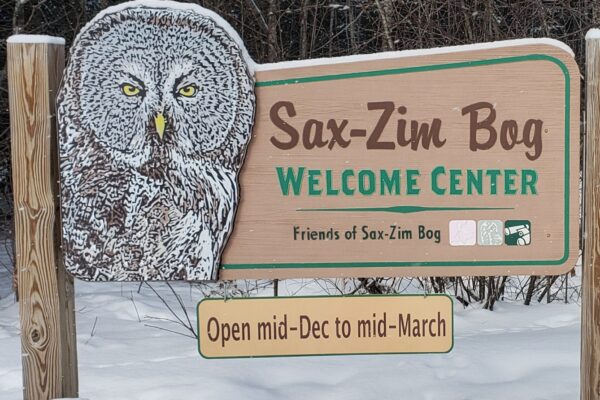
This cozy little cabin is the focal point for information about what birds have been seen where in the bog. In non-COVID times the center has a cadre of knowledgeable volunteers who will create customized routes for visitors looking for specific birds or just want an overview of the area. This year a bulletin board out front is updated regularly with recent sightings (there’s a phone number on the board you can use to talk to a volunteer). Another key tool is the Sax-Zim Bog group on the Telegram App (add the App first then click HERE to join the group). Most birders in the area regularly post on Telegram so you get real-time reports on the most sought-after boreal birds, often accompanied with their GPS location.
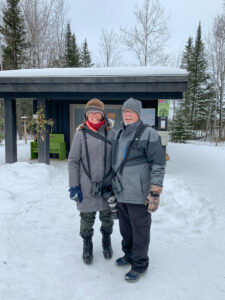
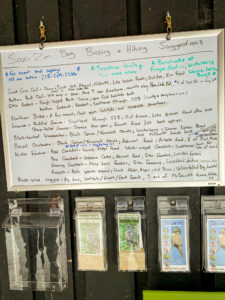
Although you could wander aimlessly down the roads, scanning the trees for birds along the way (believe me, that gets tiresome), it’s better to have a plan of attack each morning as you set out. Absent a Telegram report of a bird you’re dying to see, there are several destinations that are set up to attract birds which include private feeders, roadside feeders and bogwalks.
Residents Welcome Birders!
As I previously mentioned, I was impressed by how the community supports and encourages birding. There are at least 5 residents who have set up feeders and welcome birders to their property. In some cases they plow a large parking area just for birders’ cars so its easy to get in and out. One of our favorites was Mary Lou’s Feeders. She has set up about 25 feeders around her house which attract a wide variety of birds. On our visits there we saw Pine Grosbeaks, Evening Grosbeaks, Wild Turkeys, Hairy Woodpeckers, Common Redpoll, Red-breasted Nuthatches and other more common birds. On one visit there had to be at least 80 Evening Grosbeaks feeding there! Mary Lou’s Feeders are so popular with visitors she has her own eBird Hotspot! Mary Lou’s was also a birders’ destination because she maintains a heated Porta-Potty, complete with a variety of hand sanitizers, soaps, and odor eliminators!
Although all the private citizens who maintain feeders for birders’ benefit do so out of the kindness of their heart it must cost a lot to buy the feeders, seed, and suet not to mention, in Mary Lou’s case, paying for the Porta-Potty and the electricity to heat it! Most of the larger private sites have a donation box set up; we were happy make a contribution.
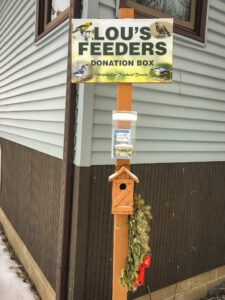
Pull Over And Birdwatch From A RoadSide Feeder
The Friends of Sax-Zim Bog have also set up several roadside feeders. These areas are designed with feeders just off the shoulder of the road; birders park their cars on the opposite shoulder and wait to see what comes in. The Admiral Road Feeders were always a popular spot and we passed by there a couple of times a day. Each of these areas has a variety of feeders, including mixed seed, thistle, sunflower, and suet. Volunteers regularly come by and refill the feeders – we didn’t see any empty ones the whole time we were there! One type of feeder at each station, was a deer carcass! Set up on a post, the carcass provides fat to the birds that feed there.
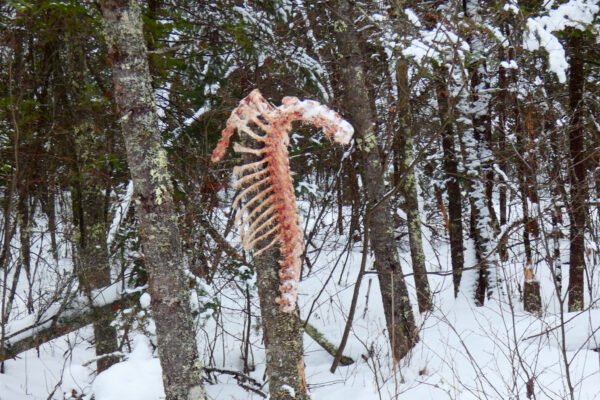
Bogwalks – A Magical Gateway to the Boreal Forest
The bogwalks were my favorite viewing areas. The Friends of Sax-Zim Bog created three boardwalks through the bog and hung feeders from the limbs of the trees bordering the walkway. Each bogwalk has feeders alongside the road, in case you don’t want to leave the warmth of your car, but I would highly recommend strolling through the welcoming archway into the boreal forest beyond the road.
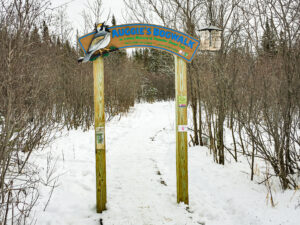
Once you enter the forest the trees close in around you and there’s a magical feeling in the air. Tall spruce and pines are scattered all around; you can look up and see their tops swaying in the breeze but the air is still around you. There’s a light haze in the air; perhaps the remnants of the frosty breaths from the thousands of birders who have walked that same boardwalk before? Black-capped Chickadees bounce around the feeders and Hairy Woodpeckers work the trunks farther up. Remember, a bog is a wetlands, so the boardwalk is constructed about 18 inches off the ground. It’s surface is covered in packed-down snow so you walk carefully. Birding Buddy Mark said that when he was last there the snow on the ground was actually higher than the boardwalk; it wasn’t that deep as we made our way around each loop.
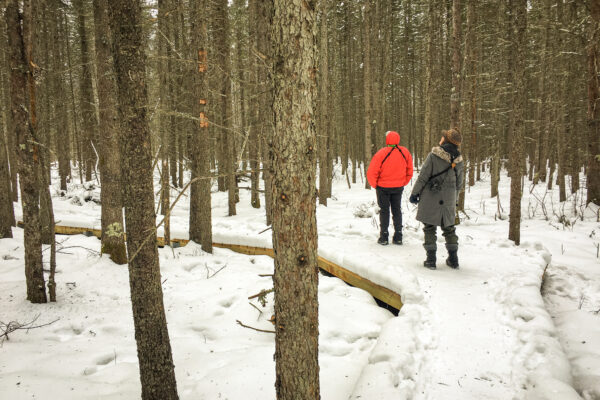
We usually started back to the hotel about sunset, scanning the trees for Great Grey Owls along Route 7. Getting back well after dark I was surprised to see we drove about 200 miles each day. Often asleep by 9:30 PM, we needed our rest for the next day’s adventures.
I can’t tell you how impressed I was with the people living in that area. To the benefit of birders from around the world they are protecting birding habitats and position feeders throughout the area just so we can share their enjoyment of birds. I know of no other place in the world like Sax-Zim Bog!
Driving 1,500 Miles for Six Lifers
We travelled north in the dead of winter to the boreal forests of Sax-Zim Bog to see birds not seen in most areas of the U.S. Over the course of three-and-a-half days and over 1,500 miles of driving we saw 25 species of birds, 6 of which were Lifers. This article presents background information and pictures of the 5 Lifers (the sixth Lifer was seen outside of The Bog and will be presented in a separate article). Another forthcoming article will highlight some of the non-Lifer (more common) birds photographed a Sax-Zim Bog like Black-capped Chickadee, Evening Grosbeak, and Common Redpoll.
Click on any bird picture to see more information about the shot.
Pine Grosbeak
Our first Lifer and the second-most numerous species (Black-capped Chickadees ruled the forest) was the Pine Grosbeak. We saw them at the Welcome Center feeders as soon as we pulled into the parking lot. They frequented feeders wherever we went and seemed most comfortable on the ground, pecking at the seeds that had fallen onto the snow. The males are most noticeable, their rose-colored body contrasted with gray wings and belly. It was the female Pine Grosbeak that I was most attracted to, with their plain gray body offset by a striking auburn-colored head and highlights.
Boreal Chickadee
We heard that the Boreal Chickadee was, if possible, even cuter than the Black-capped Chickadee. But unlike the Black-capped, which were everywhere, the Boreal Chickadee was much more difficult to find. We found out they had recently been seen at the Welcome Center feeders a half-mile down the Gray Jay Way trail and we trekked down there during our first visit, but no luck. On our third and final day we swung back by the Welcome Center for a “comfort break” and heard from a passing birder that the Boreals were back at those same feeders. So we retraced our steps down the path to the suet feeder where we found a woman who assured us they were around, if only briefly each time. Sure enough about 5 minutes later a Boreal Chickadee flew in for less than 30 seconds and then dashed back into the woods. It returned about 10 minutes later but this time it took time to forage on the ground beneath the feeder. Indeed a cute little bird!
Northern Hawk Owl
As previously mentioned, the Telegram App provided real-time information about sightings from birders in and around The Bog. As we were cruising the snow-covered roads we received a message that a Northern Hawk Owl had been spotted atop a tall tower half-way up Route 7. We hurried over (as much as you can hurry on snow-packed roads) to the area and were enthused to see several cars parked on the shoulder – the bird was still there! High atop the tower the Hawk Owl was hunkered down in the cold wind, scanning the area for prey. The Northern Hawk Owl is a member of the Owl family but acts like a hawk. Unlike most owls (but like a hawk), the Hawk Owl hunts during the day using its keen eyesight and hearing to find its prey in the snowy fields and meadows.
Black-backed Woodpecker
Telegram also informed us that a Black-backed Woodpecker was being observed at the Winterberry bogwalk and we made it over there as quickly as we could. Birders leaving the area directed us where to go. Now some Lifers are hard to find and the views of them are so brief you can’t get a decent picture of them. Not so in this case; as we walked into the woods to where the bird was reported we saw three photographers in a tight radius focused on the same tree – it was still there! In fact it stayed there for over a half-an-hour, cheerfully pecking the bark off a Tamarack Tree. I took over 325 pictures and it was still there when we decided to head back to the car half-hour later. Just a spectacular viewing of a Lifer and a relatively rare boreal bird.
Great Gray Owl
The must-see bird, the bird that helped make Sax-Zim Bog famous, is the Great Gray Owl. These are one of the tallest owls in the world and make their home in the boreal forest. Although year-round residents of Sax-Zim Bog, they emerge from the dense forest in the winter to hunt for prey near roads. We had been told to arrive at The Bog early, drive slowly (I set my cruise control for 20 MPH) and scan the roadside trees. Not seeing any, by the end of the second full day we had gotten sick of scanning the roadside trees. So by the third and last day, even though we arrived by dawn on a cloudy day with snow falling and no reports of Great Grays anywhere, we had just about given up hope of seeing one. As we slowly cruised down good old Route 7 we spotted two cars pulled off the shoulder up ahead. Could it be? We slowly pulled in behind them and jumped out the car. Sure enough a Great Gray had been spotted along the tree line about 75 yards off of the road! Eric, the man who found it, was a local guide hired by some out-of-town birders and he knew just where to look. He explained that they move into the open on dull cloudy days; on sunny days the light hurts their eyes and they stay back deep in the forest. As we watched the bird through the falling snow, it flew and perched, flew and perched. Its final perch was very obscured so we headed back to the car for a round of fist-pumps for this Lifer!
The first picture gives an indication of why it was so hard to spot while driving along the road.
Were there Lifer birds we didn’t get to see at Sax-Zim Bog? Sure there were – there’s always more to see. However we were quite satisfied with our five Lifers and have good reasons to go back and look for more some day.
Heading to Sax-Zim Bog? Do Your Homework and Be Prepared for the Elements
As noted above some basic preparation was very helpful for the trip. We had loaded the Telegram App for Sax-Zim Bog and brought along some Field Guides that included the birds we might see. By scanning the postings on Telegram for a week or so before arriving we were able to get a sense of which birds were being sighted and where. Hotel reservations are a must – ask for a “Birders’ Discount” when you make the call.
Like any birding trip to an exotic locale like the “Riviera of the Arctic” you have to prepare for the weather. The elements were kind to us – the temperatures were in the teens to low-thirties the four days we were there (although mornings hovered around single-digit temps). If we had gone the following week the temperatures would have been -10° to -20° as the high for the day! We were prepared for the worst – I regularly wore 6 layers of clothes on top and snow pants over my jeans below. We stuffed HotHands into our mittens and boots, too. These were particularly helpful after I had to remove my mittens to take pictures – my fingers ached after being exposed to the elements for more than a couple of minutes. The best advice we got – “Bring your warmest clothes!”
I hope this has been a good introduction to winter birding in Sax-Zim Bog. If you brave the elements and go, be sure to let me know – and post some of your pictures here on GreatBirdPics!
If you would like to see a collection of bird photos of the most common birds found at Sax-Zim Bog CLICK HERE.
If you would like to learn about the Evening Grosbeak (often seen at Sax-Zim Bog) and see some pictures of both the male and female CLICK HERE.
PS If you like beautiful bird pictures and want to see thousands more or even post your own on GreatBirdPics click HERE to find out more about our site.
